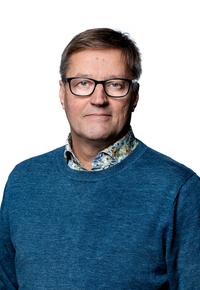Group Mikael Nilsson
Short description
Research on mechanisms and pathogenesis of thyroid cancer.
Research summary
Our lab is devoted to thyroid developmental and cancer research. The thyroid develops from anterior endoderm in the prospective pharyngeal floor and, similar to thymus and parathyroid primordia, dissociates from the site of origin and descend to its final position in the neck. The morphogenetic process involves stagewise collective migration and a surge of proliferation before progenitor cells differentiate into functional thyroid follicular cells.
We are interested in elucidating the transcriptional machinery and identity morphogens involved in regulating embryonic thyroid cell proliferation, migration and differentiation, and hypothesize that some of these mechanisms might be hijacked in thyroid tumour development, or dysregulated during tumour progression of radioresistant thyroid carcinomas that fail to respond to radioiodine (RAI) therapy.
To this purpose, we employ various transgenic mouse models that allow conditional activation or inactivation of genes of interest in the thyroid gland during different stages of organogenesis or in adult tissue, followed by phenotypic characterization of developmental defects and generated tumours. We aim to correlate tumour phenotypes with the underlaying genetic aberration and acquired somatic changes in coding and non-coding genes.
Current work focus on a BrafV600E-induced sporadic thyroid cancer model developed in our laboratory. In a separate project, we investigate human thyroid cancers with 3D-culture of micro-biopsies from primary tumours and metastases or transplanted to immunodeficient mice.
The major goal of our cancer-related work is twofold: 1) to increase the understanding of early tumour development and clonal evolution of tumour heterogeneity in the thyroid, and 2) identify thyroid-specific mechanisms of tumour dedifferentiation that might be reverted and regain cancer cell responsiveness to RAI in combination with kinase inhibitor treatment.
Research tools and resources
Main methodologies:
Mouse models of thyroid cancer; mouse models of thyroid developmental defects; in vivo lineage tracing; 3D cell culture; patient-derived xenografts (pdx) of human thyroid cancer specimens; morphological expertise including immunofluorescence and electron microscopy; routine cell and molecular biology assays including qPCR and western blot analysis.
Main collaborations:
- Martin Bergö, Karolinska Institute (mouse cancer models)
- Kajsa Paulsson, Lund university (cancer genetics)
- Carine Menhaut, IRIBHM, Brussels university (miRNA)
Current group members
Mikael Nilsson, MD, PhD, Director/Group leader at Sahlgrenska Center for Cancer Research and Professor of anatomy
Sima Kumari, PhD, Postdoc
Elin Schoultz, MD, PhD
Isak Ahlinder, PhD student
Jakob Dahlberg, MD, PhD student, endocrine surgeon
Therese Carlsson, Lab manager
Henrik Fagman, MD, PhD, clinical pathologist
Selected publications
- A branching morphogenesis program governs embryonic growth of the thyroid gland. Liang S, Johansson E, Barila G, Altschuler DL, Fagman H, Nilsson M. Development 145:dev146829, 2018
- Development of the thyroid gland (review).
Nilsson M, H Fagman. Development 144: 2123-2140, 2017
- On the origin of cells and derivation of thyroid cancer: C cell story revisited (review).
Nilsson M, Williams D. Eur Thyroid J 5:79-93, 2016
- Medullary thyroid carcinoma – distinction towards neuroectodermal tumours (letter to editor).
Nilsson M, Williams D. Eur Thyroid J Vol. 5, No. 4, 2016
- Linking loss of sodium iodide symporter expression to DNA damage.
Nordén Lyckesvärd M, Bhogal N, Ingeson C, Carlsson T, Karlsson JO, Postgård P, Himmelman J, Forssell-Aronsson E, Hammarsten O, Nilsson M. Exp Cell Res 344:120-131, 2016
- Revising the embryonic origin of thyroid C cells in mice and humans.
Johansson E, Andersson L, Örnros J, Karlsson T, Ingeson-Carlsson C, Liang S, Jansson S, Dahlberg S, Parrillo L, Zoppoli P, Barila G, Altschuler D, Padula D, Lickert H, Fagman H, Nilsson M. Development 142:3519-3528, 2015
- Differential effects of MAPK pathway inhibitors on migration and invasiveness of BRAFV600E mutant thyroid cancer cells in 2D and 3D culture.
Ingeson-Carlsson C, Martinez-Monleon A, Nilsson M. Exp Cell Res 338:127-135, 2015
- Dual contribution of MAPK and PI3K in epidermal growth factor-induced destabilization of thyroid follicular integrity and invasion of cells into extracellular matrix.
Ingeson-Carlsson C, Nilsson M. Exp Cell Res 326:201-18, 2014
- Switching from MAPK-dependent to MAPK-independent repression of the sodium-iodide symporter in 2D and 3D cultured normal thyroid cells.
Ingeson-Carlsson C, Nilsson M. Mol Cell Endocrinol 381:241-254, 2013
- Role of EphA4 receptor signaling in thyroid development: regulation of folliculogenesis and propagation of the C-cell lineage.
Andersson L, Westerlund J, Liang S, Carlsson T, Amendola E, Fagman H, Nilsson M. Endocrinology 152:1154-64, 2011

Contact information
Mikael Nilsson
Director - Sahlgrenska Center for Cancer Research
E-mail: Mikael Nilsson
Phone: +46 (0)31 786 3324
Visiting address:
Sahlgrenska Center
for Cancer Research,
Medicinaregatan 1F
413 90 Gothenburg
